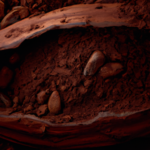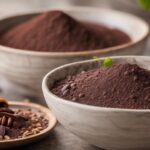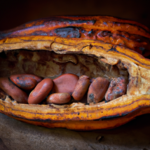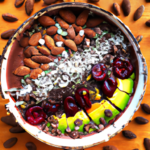Raw Food Ingredients
What Does Raw Cacao Do For The Body
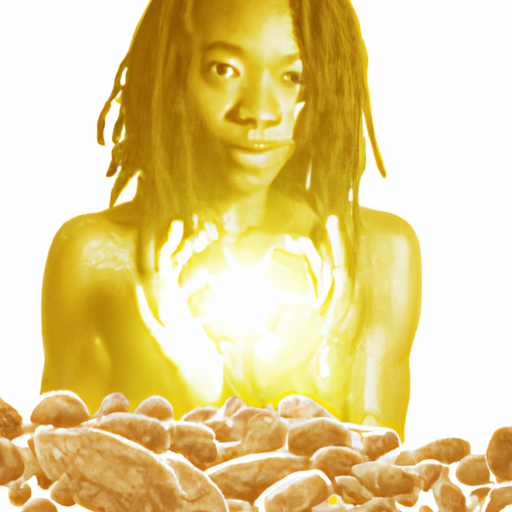
Picture yourself enjoying the luxurious, smooth flavor of a decadent chocolate delight. The scent drifts through the atmosphere, captivating your senses with its irresistible charm. Now, envision that this indulgence not only fulfills your desires but also offers amazing advantages for your body. That is the magic of raw cacao.
Raw cacao, derived from the seeds of the cacao tree, is a nutritional powerhouse packed with essential nutrients. It is a natural mood booster, improving our sense of well-being and promoting a positive outlook. Moreover, raw cacao supports cardiovascular health by reducing the risk of heart disease and improving blood flow.
But the benefits don’t stop there. Raw cacao also enhances cognitive function and brain health, aids in weight management, promotes healthy skin, boosts energy and endurance, and improves gut health and digestion.
In this article, we will explore the extensive benefits that raw cacao brings to our bodies. So, grab a cup of hot cocoa and join me on this enlightening journey into the wonders of raw cacao.
Key Takeaways
- Raw cacao helps achieve/maintain healthy weight
- Offers benefits for skin health and anti-aging effects
- Provides energy and endurance boost
- Supports gut health and digestion
Nutritional Profile of Raw Cacao
Raw cacao is bursting with nutrients, like magnesium, iron, and antioxidants, that nourish and support the body’s overall health. These nutrients have various benefits for athletes, such as magnesium’s role in muscle function and iron’s contribution to oxygen transport.
Additionally, raw cacao contains minerals like calcium and phosphorus, which play a crucial role in maintaining bone health. The antioxidants found in raw cacao, such as flavonoids, have been shown to reduce inflammation and protect against oxidative stress, which can benefit athletes during intense training.
Furthermore, raw cacao is a rich source of vitamins, including B vitamins, which are essential for energy production and metabolism.
Moving on to the next section about mood-boosting properties, research suggests that raw cacao may have positive effects on mood and overall well-being.
Mood-Boosting Properties
Indulging in cacao can instantly uplift your spirits and put a smile on your face. Raw cacao has mood-boosting benefits due to its ability to increase serotonin production, a neurotransmitter that plays a crucial role in regulating mood and promoting feelings of happiness and well-being. Additionally, raw cacao is rich in antioxidants, minerals, and vitamins that contribute to various aspects of health. These nutrients, such as magnesium and zinc, support brain function and help regulate neurotransmitters involved in mood regulation. Raw cacao also contains phenylethylamine, a compound that promotes the release of endorphins, further enhancing mood. Scientific research and studies have shown the positive effects of raw cacao on mood, making it a natural and delicious way to improve your emotional well-being. Moving on to cardiovascular health benefits…
Cardiovascular Health Benefits
Consuming cacao can contribute to improved cardiovascular health. Studies have shown that regular consumption of dark chocolate, which contains high levels of cacao, can lower the risk of heart disease by up to 37%. This is due to the various components found in cacao that have been linked to cardiovascular benefits.
For example, cacao is rich in antioxidants, such as flavonoids, which help reduce inflammation and oxidative stress in the body. Additionally, cacao contains minerals like magnesium and potassium, which are important for maintaining a healthy heart and blood pressure.
Furthermore, the consumption of cacao has been shown to improve lipid profiles by reducing LDL cholesterol levels and increasing HDL cholesterol levels. These cholesterol-modulating effects can further contribute to cardiovascular health.
Transitioning into the next section about cognitive function and brain health, it is important to note that the benefits of cacao extend beyond just the cardiovascular system.
Cognitive Function and Brain Health
Raw cacao has been shown to have positive effects on cognitive function and brain health. It enhances focus and concentration, allowing individuals to better concentrate on tasks and improve their productivity.
In addition, raw cacao supports memory and learning by promoting blood flow to the brain and supplying it with essential nutrients.
Furthermore, raw cacao contains powerful antioxidants that help protect against neurodegenerative diseases, such as Alzheimer’s and Parkinson’s, by reducing inflammation and oxidative stress in the brain.
Enhances Focus and Concentration
Boost your mental clarity and laser-like focus with the power of raw cacao. This natural superfood contains a combination of compounds that can enhance your ability to concentrate and stay focused. Here are four ways raw cacao can improve your focus and concentration:
-
Stimulates blood flow: Raw cacao contains flavanols, which can increase blood flow to the brain. This improved circulation helps deliver essential nutrients and oxygen, supporting optimal brain function.
-
Enhances neurotransmitter activity: Raw cacao contains phenylethylamine (PEA), a compound that promotes the release of dopamine and serotonin. These neurotransmitters play a crucial role in regulating mood and focus.
-
Provides caffeine-like effects: Raw cacao contains a small amount of natural caffeine, which can provide a mild stimulant effect. This can help increase alertness and improve concentration.
-
Reduces oxidative stress: The antioxidants found in raw cacao, such as flavonoids, help fight against free radicals and reduce oxidative stress in the brain. This can contribute to improved cognitive function and focus.
By enhancing focus and concentration, raw cacao sets the stage for improved memory and learning.
Supports Memory and Learning
Improve your ability to remember and learn with the help of raw cacao’s support for memory and learning.
Raw cacao contains various nutrients that contribute to cognitive function and memory support. First, it is rich in antioxidants, such as flavonoids, which have been shown to improve memory and protect against age-related cognitive decline.
Additionally, raw cacao is a good source of minerals like magnesium, which plays a crucial role in brain health and memory formation.
Moreover, cacao contains vitamins, including B vitamins, which support brain function and neurotransmitter synthesis. These nutrients work together to enhance cognitive abilities, including memory retention and learning capacity.
Incorporating raw cacao into your diet may help support memory and improve overall cognitive function.
Moving forward, we will explore how raw cacao protects against neurodegenerative diseases.
Protects Against Neurodegenerative Diseases
Incorporating raw cacao into your diet can be like building a fortress for your brain, protecting it against the relentless onslaught of neurodegenerative diseases. Raw cacao is rich in antioxidants, minerals, and vitamins that contribute to various aspects of health, including brain health.
Research has shown that the antioxidants in raw cacao have neuroprotective effects, helping to reduce oxidative stress and inflammation in the brain. These effects can potentially slow down the progression of neurodegenerative diseases such as Alzheimer’s and Parkinson’s.
Additionally, raw cacao contains flavonoids that improve blood flow to the brain, enhancing cognitive function and memory. Consuming raw cacao regularly may therefore help support brain health and reduce the risk of developing these debilitating conditions.
Transitioning into the subsequent section about ‘weight management’, it is important to note that raw cacao can also be beneficial for maintaining a healthy weight.
Weight Management
Maintaining a healthy weight becomes easier when you include raw cacao in your diet. Raw cacao contains a variety of nutrients that can contribute to weight management and appetite control. It is rich in fiber, which helps to promote feelings of fullness and reduce overeating. Additionally, raw cacao contains compounds that may have a positive impact on metabolism and fat oxidation. Studies have shown that consuming cacao can increase energy expenditure and enhance fat burning. Furthermore, the antioxidants present in raw cacao can help to reduce inflammation and improve insulin sensitivity, which are important factors in weight management. Incorporating raw cacao into a balanced diet can be a beneficial strategy for those looking to achieve or maintain a healthy weight. Transitioning to the next section, raw cacao also offers benefits for skin health and anti-aging effects.
Skin Health and Anti-Aging Effects
Get ready to discover how raw cacao can work wonders for your skin, giving you a youthful and radiant glow.
The anti-inflammatory effects of raw cacao can help reduce skin redness, inflammation, and irritation. Additionally, raw cacao is rich in antioxidants, minerals, and vitamins, which play a crucial role in collagen production. Collagen is a protein that keeps our skin firm and elastic, preventing the formation of wrinkles and fine lines.
The antioxidants present in raw cacao also protect the skin from free radicals, which can cause premature aging. Scientific research and studies have shown that consuming raw cacao or applying it topically can improve skin health and promote a more youthful appearance.
Transitioning into the next section, raw cacao not only benefits the skin but also provides an energy and endurance boost.
Energy and Endurance Boost
Boost your energy and endurance to superhero levels with the amazing power of raw cacao. Here are four ways that raw cacao can enhance your energy levels and athletic performance:
-
Increased blood flow: Raw cacao contains flavonoids and theobromine, which help dilate blood vessels and improve circulation. This increased blood flow delivers more oxygen and nutrients to your muscles, giving you a boost in energy.
-
Enhanced stamina: The magnesium content in raw cacao supports muscle function and helps reduce fatigue. By incorporating raw cacao into your diet, you may experience improved endurance during physical activities.
-
Mental alertness: Raw cacao contains small amounts of caffeine, a natural stimulant that can increase focus and alertness. This can be particularly beneficial for athletes looking for an extra mental edge during competitions or workouts.
-
Reduced inflammation: The antioxidants found in raw cacao have been shown to have anti-inflammatory properties. Lower levels of inflammation can help support faster muscle recovery and reduce the risk of injury.
By incorporating raw cacao into your diet, you can boost your energy and endurance levels, leading to improved athletic performance.
Now, let’s explore the next topic of ‘gut health and digestive benefits.’
Gut Health and Digestive Benefits
Improving your gut health and digestion can be a game-changer for overall well-being and performance. Raw cacao can play a beneficial role in this aspect.
The gut microbiome, which consists of trillions of microorganisms, plays a vital role in digestion and overall health. Raw cacao contains polyphenols, which have been shown to have a positive impact on the gut microbiome by promoting the growth of beneficial bacteria.
Additionally, raw cacao contains digestive enzymes, such as amylase and lipase, which help break down carbohydrates and fats, aiding in digestion. These enzymes can enhance nutrient absorption and reduce digestive discomfort.
Incorporating raw cacao into your diet can support a healthy gut and optimize digestion.
Transitioning into the subsequent section, let’s explore how to incorporate raw cacao into your daily routine.
Incorporating Raw Cacao into Your Diet
To make the most of raw cacao’s benefits, you can easily incorporate it into your daily routine.
One way to incorporate raw cacao is by using it in recipes. Raw cacao can be added to baked goods, such as cookies or brownies, to enhance their flavor and provide a nutritional boost.
You can also sprinkle raw cacao nibs on top of yogurt or oatmeal for added crunch and chocolatey goodness.
Another way to enjoy the benefits of raw cacao is by adding it to smoothies. Raw cacao powder can be blended with fruits, vegetables, and a liquid of your choice to create a delicious and nutritious smoothie.
By incorporating raw cacao into your diet, you can reap the benefits of its antioxidants, minerals, and vitamins, which contribute to various aspects of health.
Frequently Asked Questions
Can raw cacao help with reducing the risk of heart disease?
Raw cacao may help reduce the risk of heart disease by reducing inflammation and improving blood flow. Its antioxidants, minerals, and vitamins contribute to cardiovascular health, supported by scientific research and studies.
Is raw cacao beneficial for improving cognitive function and memory?
Raw cacao has been found to improve focus and enhance brain health. It contains antioxidants, minerals, and vitamins that support cognitive function and memory. Scientific research supports the benefits of raw cacao for brain health.
Can consuming raw cacao help with weight loss?
Consuming raw cacao can potentially aid in weight loss due to its effects on metabolism and appetite suppression. Raw cacao contains compounds that can boost metabolism and reduce cravings, supporting weight management efforts.
Does raw cacao have any negative effects on the skin?
Negative effects of raw cacao on the skin may include allergic reactions. It is important to note that while raw cacao has numerous benefits for the body, it is always recommended to consult with a healthcare professional before making any dietary changes.
How much raw cacao should be consumed to experience its health benefits?
To experience the health benefits of raw cacao, it is recommended to consume a moderate amount. Incorporating raw cacao into a balanced diet can contribute to heart disease prevention, cognitive function improvement, memory enhancement, and weight loss aid. The effects on the skin are minimal.
How Does Raw Cacao Benefit the Body?
Raw cacao benefits explained include a high antioxidant content, which can help reduce oxidative stress in the body. It also contains minerals like magnesium, which is essential for muscle and nerve function. Additionally, raw cacao may have mood-boosting effects due to its ability to release endorphins.
Conclusion
In conclusion, raw cacao offers a plethora of benefits for the body. Its rich nutritional profile, including antioxidants, minerals, and vitamins, supports cardiovascular health, cognitive function, weight management, and skin health.
Additionally, raw cacao’s mood-boosting properties, energy and endurance boost, and positive effects on gut health make it a valuable addition to any diet.
Incorporating raw cacao into your daily routine can provide numerous health advantages backed by scientific research. So go ahead, indulge in the delicious and nutritious goodness of raw cacao for a healthier you.
Rachael, the Editor in Chief of RachaelsRawFood.com, is an inspiring and passionate individual who has dedicated her life to promoting the benefits of a raw food lifestyle. Known for her vibrant and energetic personality, Rachael has built a strong online presence that has transformed her personal journey into a thriving community of raw food enthusiasts.
Raw Food Ingredients
How Much Caffeine in Cocoa?
Not all cocoa products are created equal when it comes to caffeine content – discover which one might surprise you!

When evaluating the caffeine levels in cocoa, it’s important to recognize that dark chocolate contains around 43 mg of caffeine per 100 grams due to its high cocoa solid content. Dark chocolate has a higher caffeine content compared to milk or white chocolate. This means that consuming dark chocolate in moderation can assist in managing your caffeine intake. On the other hand, milk chocolate has around 20 mg of caffeine per 100 grams while white chocolate is caffeine-free. Cocoa powder, commonly used in baking and beverages, contains a substantial 230 mg of caffeine per 100 grams. Being aware of these distinctions in chocolates can help you make informed decisions about your caffeine consumption.
Key Takeaways
- Caffeine content in cocoa varies based on cocoa solid concentrations.
- Unsweetened cocoa powder can contain around 230 mg of caffeine per 100 grams.
- Roasting cocoa solids influences the final caffeine content in cocoa products.
- Dark chocolate, with high cocoa solid content, has more caffeine than milk chocolate.
- Moderate consumption of cocoa products helps manage caffeine intake.
Caffeine Content in Dark Chocolate
Dark chocolate boasts a caffeine content of approximately 43 mg per 100 grams, mainly deriving from its higher cocoa solid composition. When we indulge in this decadent treat, we aren't only savoring its rich cocoa flavor but also a subtle caffeine kick. Compared to milk or white chocolate, dark chocolate contains a higher amount of caffeine.
Please bear in mind that moderate consumption of dark chocolate can assist individuals in managing their caffeine intake effectively. The caffeine levels in dark chocolate are about one-fourth of what you'd find in a standard cup of coffee. So, if you're looking for a milder caffeine boost, a piece of dark chocolate might just do the trick without the jitters that sometimes accompany a strong cup of coffee.
Enjoy your dark chocolate in moderation, savoring both its taste and the gentle pick-me-up it provides.
Caffeine Levels in Milk Chocolate

Milk chocolate, known for its creamy texture and sweet flavor, contains a modest caffeine content of approximately 5.6 mg per ounce, as indicated by USDA data. Unlike dark chocolate, milk chocolate has a lighter color due to lower cocoa content, resulting in reduced caffeine levels.
The delightful creamy taste in milk chocolate comes from a harmonious blend of cocoa and milk powder. While dark chocolate boasts higher caffeine content, milk chocolate remains a popular choice for those seeking a sweet treat with minimal caffeine intake.
Caffeine Presence in White Chocolate
With its unique composition excluding cocoa solids, white chocolate stands out as a caffeine-free alternative to its darker counterparts. White chocolate is crafted from a blend of cocoa butter, milk powder, sugar, and vanilla, making it a delectable treat without the stimulating effects of caffeine. For individuals sensitive to caffeine, white chocolate offers a creamy texture and indulgent flavor without the worry of unwanted side effects. This makes it a popular choice for desserts among those looking to steer clear of caffeine in their sweet treats.
Compared to dark chocolate, which contains cocoa solids and hence caffeine, white chocolate provides a caffeine-free option for those seeking a more mellow indulgence. So, if you're in the mood for a luscious and smooth chocolate experience without the buzz of caffeine, white chocolate is the perfect choice for your next dessert delight.
Impact of Cocoa Solids on Caffeine

In determining the caffeine levels in cocoa products, the percentage of cocoa solids plays a significant role. Here are some key points about the impact of cocoa solids on caffeine content:
- Caffeine Derivation: The caffeine content in cocoa primarily comes from cocoa solids, making it an important factor in determining the overall caffeine levels in cocoa-based products.
- Dark Chocolate: Dark chocolate, known for its higher cocoa solid content, tends to contain more caffeine compared to milk or white chocolate varieties due to this higher concentration.
- Unsweetened Cocoa Powder: A 100g serving of unsweetened cocoa powder can contain around 230mg of caffeine, reflecting the impact of the high cocoa solid content in this form.
- Health Benefits: The roasting process of cocoa solids not only affects the flavor profile but also influences the caffeine content, contributing to the potential health benefits associated with consuming cocoa products like hot cocoa.
Comparing Caffeine in Different Chocolates
Comparing the caffeine content in different chocolates reveals varying levels based on their cocoa solid concentrations. Dark chocolate contains about 43 mg of caffeine per 100 grams, making it a stronger caffeinated option compared to milk chocolate, which only has around 20 mg per 100 grams.
Surprisingly, white chocolate, derived from cocoa butter, doesn't contain any caffeine at all. For those seeking a more potent caffeine kick, cocoa powder is the way to go, boasting a high concentration of 230 mg per 100 grams.
The amount of caffeine in chocolate products is closely linked to the cocoa solid content, with dark chocolate containing the highest levels. So, the next time you're craving a chocolate treat but also need a little energy boost, opt for dark chocolate to get the most caffeine per bite.
Frequently Asked Questions
Is There More Caffeine in Cocoa Than Coffee?
There's more caffeine in cocoa than in coffee. Cocoa powder packs 230 mg per 100 grams, surpassing most coffee varieties. Dark chocolate has even more caffeine due to higher cocoa content. It's a rich, unique energy source.
Is There a Lot of Caffeine in Hot Cocoa?
There isn't a lot of caffeine in hot cocoa. It depends on the brand and recipe. Starbucks hot chocolate has around 25 mg per serving, while basic mixes have about 5 mg. The amount of cocoa powder used influences the caffeine content.
Is There Caffeine in Hershey's Cocoa?
Absolutely, Hershey's Cocoa does contain caffeine, but it's not overwhelming. It adds a delightful hint of energy in each spoonful. Perfect for baking or a cozy cup of hot chocolate. Just the right amount!
Is Cocoa a Stimulant Like Caffeine?
Cocoa stimulates like caffeine due to its theobromine content. Decaf versions offer a solution for caffeine-sensitive folks. Options include regular cocoa with caffeine, Dutch-processed cocoa with less, and decaf cocoa with reduced caffeine while keeping healthful compounds.
What are the potential health effects of consuming high levels of caffeine in cocoa?
Unveiling cocoa caffeine levels can lead to potential health effects of excessive consumption. High levels of caffeine in cocoa may contribute to insomnia, nervousness, and fast heartbeat. It can also cause gastrointestinal discomfort and exacerbate anxiety disorders. Moderation in consuming caffeinated cocoa products is recommended for overall health.
Conclusion
To sum up, the caffeine content in cocoa varies depending on the type of chocolate. Dark chocolate typically has the highest caffeine levels, followed by milk chocolate and white chocolate. The amount of cocoa solids in the chocolate also affects the caffeine content.
Remember, just like different chocolates have different levels of caffeine, we all have unique strengths and abilities. Embrace your individuality and always aim for balance in everything you do.
Rachael, the Editor in Chief of RachaelsRawFood.com, is an inspiring and passionate individual who has dedicated her life to promoting the benefits of a raw food lifestyle. Known for her vibrant and energetic personality, Rachael has built a strong online presence that has transformed her personal journey into a thriving community of raw food enthusiasts.
Raw Food Ingredients
5 Key Differences: Caffeine Content in Cocoa Vs Coffee
Open the door to understanding the contrasting caffeine levels in cocoa and coffee, revealing surprising insights that will reshape your beverage choices.

When comparing the caffeine levels in cocoa and coffee, it is important to understand that cocoa generally has lower caffeine content than coffee. Dark chocolate contains approximately 12 milligrams of caffeine per ounce, while hot cocoa typically ranges from 5 to 10 milligrams per ounce. In contrast, brewed coffee can have significantly higher levels, varying from 95 to 165 milligrams per 8-ounce cup.
Cocoa is considered a milder option for individuals aiming to limit their caffeine intake, with theobromine providing a gradual energy increase. Meanwhile, coffee's caffeine content offers immediate alertness, and understanding these distinctions can help you select based on your preferred effects.
Key Takeaways
- Cocoa contains lower caffeine levels but compensates with theobromine for a gradual energy increase.
- Coffee has higher caffeine content, offering an immediate alertness boost and potentially higher metabolic rate.
- Theobromine in cocoa promotes relaxation, while caffeine in coffee provides intense alertness and mood fluctuations.
- Hot chocolate is a good option for reducing caffeine intake while still benefiting from theobromine effects.
- Understanding caffeine variances helps make informed choices for desired energy levels and mood effects.
Caffeine Levels in Cocoa Vs Coffee
When comparing caffeine levels in cocoa versus coffee, it's evident that cocoa generally contains lower amounts per serving. Dark chocolate, made from cacao beans, contains around 12 milligrams of caffeine per ounce, while a 1-ounce serving of hot cocoa mix typically has 5-10 milligrams. Even a 16-ounce serving of Starbucks hot chocolate only contains about 25 milligrams of caffeine.
On the other hand, coffee, when brewed, can range from 95 to 165 milligrams of caffeine per 8-ounce cup, depending on the type and brewing method. This significant difference in caffeine content between cocoa and coffee makes cocoa a milder option for those looking to limit their caffeine intake.
Impact on Alertness and Energy

Typically, the immediate alertness and energy boost from caffeine in coffee can last for hours. This surge in alertness is due to caffeine's stimulating effect on the central nervous system. On the other hand, cocoa contains theobromine, which provides a more gradual increase in energy levels. Unlike caffeine, theobromine doesn't cause sudden spikes and crashes, offering a smoother energy curve.
Coffee's caffeine content can temporarily boost the metabolic rate, potentially supporting weight management efforts. This increased metabolic rate can aid in burning calories and may contribute to weight loss when combined with a balanced diet and regular exercise. Additionally, theobromine in cocoa contributes to the thermogenic effect, leading to mild calorie burning in the body.
Both caffeine and theobromine can influence mood. Caffeine tends to provide a more intense and quick-acting mood elevation, while theobromine promotes feelings of relaxation and contentment. Understanding the differences in alertness, energy, metabolic effects, and mood enhancements between cocoa and coffee can help individuals make informed choices based on their preferences and wellness goals.
Metabolic Variances and Effects
Regarding metabolic variances and effects, the varying caffeine levels between cocoa and coffee play a significant role. When comparing the metabolic impact of caffeine in cocoa and coffee, it is crucial to note that cocoa contains lower levels of caffeine but compensates with theobromine, which aids in the thermogenic effect, promoting calorie burning and metabolic activity. On the other hand, coffee, especially brewed varieties, contains higher levels of caffeine, potentially providing a temporary boost to the metabolic rate, which could assist in weight management. While caffeine in coffee offers a quick energy surge, theobromine in cocoa leads to a more gradual rise in energy levels, avoiding sudden spikes and crashes. To summarize the metabolic differences, I've created a table below:
| Aspect | Cocoa | Coffee |
|---|---|---|
| Caffeine Content | Lower levels | Higher levels |
| Additional Component | Theobromine | Caffeine |
| Metabolic Impact | Thermogenic effect | Temporary metabolic rate boost |
| Energy Levels | Gradual rise | Quick surge |
| Weight Management | Aids in calorie burning | Potential assistance |
Mood Enhancement Disparities

In comparing the mood enhancement effects of theobromine in cocoa and caffeine in coffee, notable disparities emerge in their impact on mental well-being.
The theobromine found in cocoa promotes relaxation and contentment, offering a gradual rise in energy levels that leads to a gentle and long-lasting mood enhancement experience.
On the other hand, caffeine delivers an intense and fast-acting boost in alertness, providing immediate energy levels that can lead to abrupt spikes and crashes.
While both theobromine and caffeine uplift mood, theobromine's effects are characterized by a steady and gradual increase in energy levels, creating a sense of calm and contentment.
In contrast, caffeine's impact is more intense and temporary, resulting in rapid alertness but also the potential for fluctuations in mood. Understanding these differences can help individuals choose between cocoa and coffee based on their desired mood enhancement effects.
Health Implications and Considerations
Health implications and considerations surrounding caffeine consumption warrant close attention due to its potential impact on various aspects of well-being. When comparing a cup of coffee to hot chocolate, it's vital to note the amount of caffeine present.
While coffee contains much caffeine, hot chocolate has less caffeine but isn't entirely devoid of it. The main active ingredients in hot chocolate are theobromine and caffeine, where theobromine is a relative of caffeine and also has stimulant effects, although milder. If you're looking to reduce your caffeine intake, opting for hot chocolate over a cup of coffee can be a good choice.
Being mindful of the caffeine content in chocolate products is important, especially if you're sensitive to caffeine or belong to vulnerable populations like children or pregnant women. Understanding the caffeine levels in different beverages allows you to make informed decisions about your consumption for better overall health.
Frequently Asked Questions
Is There Caffeine in Coffee Vs Cacao Powder?
Yes, there is caffeine in coffee, with around 140 milligrams in a 12-ounce cup. On the other hand, cacao powder contains only about 12 milligrams per tablespoon, making it a great caffeine-free alternative for those seeking a milder boost.
What Is the Difference Between Cocoa and Coffee?
When comparing cocoa and coffee, cocoa offers a rich, chocolatey flavor and is packed with antioxidants and minerals. Coffee, on the other hand, provides a robust, bitter taste and a jolt of caffeine for that morning pick-me-up.
Why Is Cocoa Better Than Coffee?
I believe cocoa is superior to coffee because it offers a gentler energy boost, promotes relaxation and contentment, and provides sustained vitality without sudden crashes. Plus, dark chocolate's theobromine supports cellular health and tastes delicious.
How Much Caffeine Is in Cocoa Powder Vs Decaf Coffee?
In cocoa powder vs decaf coffee, cocoa has 12-26mg of caffeine per tbsp, while decaf coffee holds 2-5mg per 8-ounce cup. The choice hinges on desired caffeine levels and flavor. I prefer cocoa's lower caffeine content.
How does the caffeine content in hot chocolate compare to coffee?
Hot chocolate caffeine content is significantly lower than that of coffee. While an 8-ounce cup of hot chocolate contains about 5-10 milligrams of caffeine, the same size of coffee can have anywhere from 95-200 milligrams. It’s a notable difference for those looking to limit their caffeine intake.
Conclusion
To sum up, while cocoa and coffee both contain caffeine, the levels vary significantly. Cocoa generally has lower caffeine content compared to coffee, impacting alertness, energy levels, and mood enhancement differently.
It's crucial to keep these differences in mind when choosing between the two beverages for your daily consumption. Remember, moderation is key to maintaining a healthy balance in your caffeine intake.
So, whether you prefer a cup of cocoa or a mug of coffee, enjoy it in moderation for the best benefits!
Rachael, the Editor in Chief of RachaelsRawFood.com, is an inspiring and passionate individual who has dedicated her life to promoting the benefits of a raw food lifestyle. Known for her vibrant and energetic personality, Rachael has built a strong online presence that has transformed her personal journey into a thriving community of raw food enthusiasts.
Raw Food Ingredients
A Guide to Becoming a Good King
Kingship demands wisdom, fairness, integrity, courage, and humility – essential traits for a successful reign and prosperous kingdom." Keep reading to uncover the secrets of becoming a good king.

In order to be a good king, one must embody wisdom, fairness, integrity, courage, and humility to lead the kingdom with honor. Wisdom is essential for making important decisions, fairness ensures just treatment for all, integrity builds trust and respect, courage is crucial for facing challenges, and humility reminds us of our humanity. Historical kings such as Solomon, Arthur, David, Charlemagne, and Ramses II serve as role models for these leadership traits.
As a king, embracing challenges, understanding the world, seeking personal growth, and learning from the past are essential responsibilities. Developing leadership skills, making wise decisions, and prioritizing the well-being of the people are key to effective kingship. Every step on the path to becoming a good king is critical for a successful reign and prosperous kingdom.
Key Takeaways
- Embrace wisdom for informed decisions.
- Practice fairness for just treatment.
- Uphold integrity to earn trust.
- Show courage in facing challenges.
- Maintain humility for empathy and respect.
Qualities of a Good King
Being a good king requires embodying qualities such as wisdom, fairness, integrity, courage, humility, and compassion in decision-making and leadership. Power comes with responsibility, and as a king, it's essential to wield this power wisely. Wisdom is vital in making sound judgments that benefit the kingdom as a whole. Fairness guarantees that all subjects are treated justly and equitably, fostering a harmonious society. Integrity is the foundation of trust and respect, key elements in effective leadership.
Courage is necessary to face challenges and make difficult decisions, even when met with opposition. Humility reminds a king of his humanity and the importance of humility in interactions with all subjects. Compassion demonstrates a king's care and empathy towards his people, fostering a sense of unity and loyalty. Effective communication is crucial for conveying decisions, listening to concerns, and inspiring confidence in leadership.
Historical Kings as Role Models

King Solomon, renowned for his wisdom and leadership, stands as an exemplar among historical kings who serve as role models for future leaders. Looking at figures like King Arthur, known for his justice and valor in medieval legends, and King David, celebrated for his faith and courage in battle, we find lessons that transcend time. Charlemagne's legacy of military conquests and cultural revival, alongside Ramses II's grand building projects and military campaigns, offer diverse insights into effective kingship. Below is a table summarizing key attributes of these historical kings:
| King | Attributes |
|---|---|
| King Solomon | Wisdom, leadership |
| King Arthur | Justice, valor |
| King David | Faith, courage |
| Charlemagne | Military prowess, culture revival |
| Ramses II | Building projects, military campaigns |
Studying these historical figures can provide valuable lessons on the multifaceted qualities that make a great ruler.
Responsibilities of Kingship
Embracing challenges and living authentically are central to fulfilling the responsibilities inherent in kingship. As men aspiring to be good kings, it's essential for us to understand that the world requires leaders who are kind, humble, and committed to personal growth.
The journey to becoming a good king involves more than just wielding power and responsibility—it entails sacrificing comfort for growth and transformation. Seeking the ancient path of masculinity, as exemplified by figures like Morgan, teaches us the importance of humility, vulnerability, and character development.
In fulfilling the responsibilities of kingship, we're entrusted with power not for our own gain, but for the betterment of the world around us. Just as seeds need Good Soil to flourish, we must nurture our own growth to lead effectively.
Leadership Skills for Kings

Developing essential leadership skills is crucial for aspiring kings seeking to fulfill their responsibilities with humility, vulnerability, and a focus on character development. As you study the world around us, the power and responsibility of what kingship entails become clearer. Here are some key points to think about on your path to becoming a king:
- Embrace challenges and live authentically.
- Seek ancient paths of masculinity for guidance.
- Reflect on your identity, purpose, and ability to be entrusted with power for good.
- Sacrifice comfort for growth, transformation, and participation in universal creativity.
The journey of becoming a king isn't just about gaining authority but about understanding the remarkable fellowship of like-hearted individuals who share similar goals. Engage in group discussion questions, consider between-session personal study, and explore the depths of your masculine soul. This is the path to restoring what it means to be a true king.
Importance of Wise Decision-Making
Steering through the intricacies of leadership, especially in the domain of kingship, requires a sharp focus on the art of prudent decision-making. Wise decision-making is like the compass guiding the ship of leadership towards success.
Good kings understand that their choices impact not just themselves but also the lives of those they rule over. They prioritize the well-being of their people over personal gains, embodying the essence of true leadership.
Seeking counsel from trusted advisors and reflecting on core values are essential practices in the domain of wise decision-making. By embracing humility and self-awareness, kings can navigate the complex web of choices with clarity and integrity.
Just like a six-session video Bible study can guide individuals in restoring the heart, wise decision-making is essential for becoming the kind of leaders our world needs. Let's start on this journey of radical reconstruction, where every decision is a step towards being counted among the good kings of history.
Frequently Asked Questions
What Is the Becoming a King Guide?
The Becoming a King guide is a transformative resource created by Morgan Snyder to help men grow into responsible kings. It offers practical tools and profound insights to aid personal development and transformation.
What Are the Qualities of a Good King?
Being a good king means embodying humility, wisdom, and integrity. Prioritizing the well-being of my people, making decisions for the greater good, and showing courage, justice, and compassion in all actions. Seeking counsel and valuing diverse perspectives is essential.
What Makes a True King?
Beneath the crown lies a heart that beats with humility and a spirit that soars with honor. True kings are forged in the fires of challenge, embracing authenticity and growth to inspire others.
What Makes a Real King?
Being a true king means embodying humility, courage, and empathy. It's about serving others and leading with integrity. I endeavor to cultivate these qualities daily, embracing challenges and seeking growth in all aspects of my life.
How Can Sacred Cacao be Incorporated Into Kingship Rituals?
In kingship rituals, the sacred cacao ritual holds great significance. The ceremonial drinking of cacao symbolizes the divine connection between the ruler and the spiritual realm. It is believed to impart wisdom and strength, making it a crucial element in the coronation and leadership rites of many cultures.
Conclusion
To sum up, becoming a good king requires a combination of qualities, skills, and responsibilities. Remember, 'With great power comes great responsibility.'
By studying historical kings as role models, practicing leadership skills, and making wise decisions, one can aspire to be a just and effective ruler.
It's a challenging path, but with dedication and perseverance, anyone can endeavor to be a worthy leader for their kingdom.
Rachael, the Editor in Chief of RachaelsRawFood.com, is an inspiring and passionate individual who has dedicated her life to promoting the benefits of a raw food lifestyle. Known for her vibrant and energetic personality, Rachael has built a strong online presence that has transformed her personal journey into a thriving community of raw food enthusiasts.
-

 Health and Wellness2 months ago
Health and Wellness2 months agoDoes Eating Raw Food Help You Lose Weight? Discover the Truth
-

 Raw Food Recipes2 months ago
Raw Food Recipes2 months agoHow Much Raw Food to Feed Your Puppy: Essential Tips
-

 Kitchen Essentials for Raw Food Preparation1 month ago
Kitchen Essentials for Raw Food Preparation1 month agoCan You Cook Raw Food in an Air Fryer? Discover the Possibilities
-

 Raw Food Recipes2 months ago
Raw Food Recipes2 months agoHow to Defrost Dog Raw Food Properly
-

 Health and Wellness2 months ago
Health and Wellness2 months agoHow Long Does It Take Bacteria to Spread From Raw Food? Essential Info
-
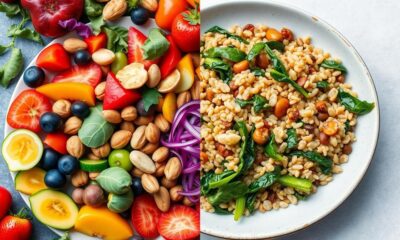
 Raw Food Recipes2 months ago
Raw Food Recipes2 months agoRaw Food Vs. Vegan: Which Diet Is Better?
-

 Raw Food Recipes2 months ago
Raw Food Recipes2 months agoIs Raw Food Good for Cats? Find Out Here
-

 Raw Food Recipes2 months ago
Raw Food Recipes2 months agoWhat Is the Raw Food Diet? A Comprehensive Overview


